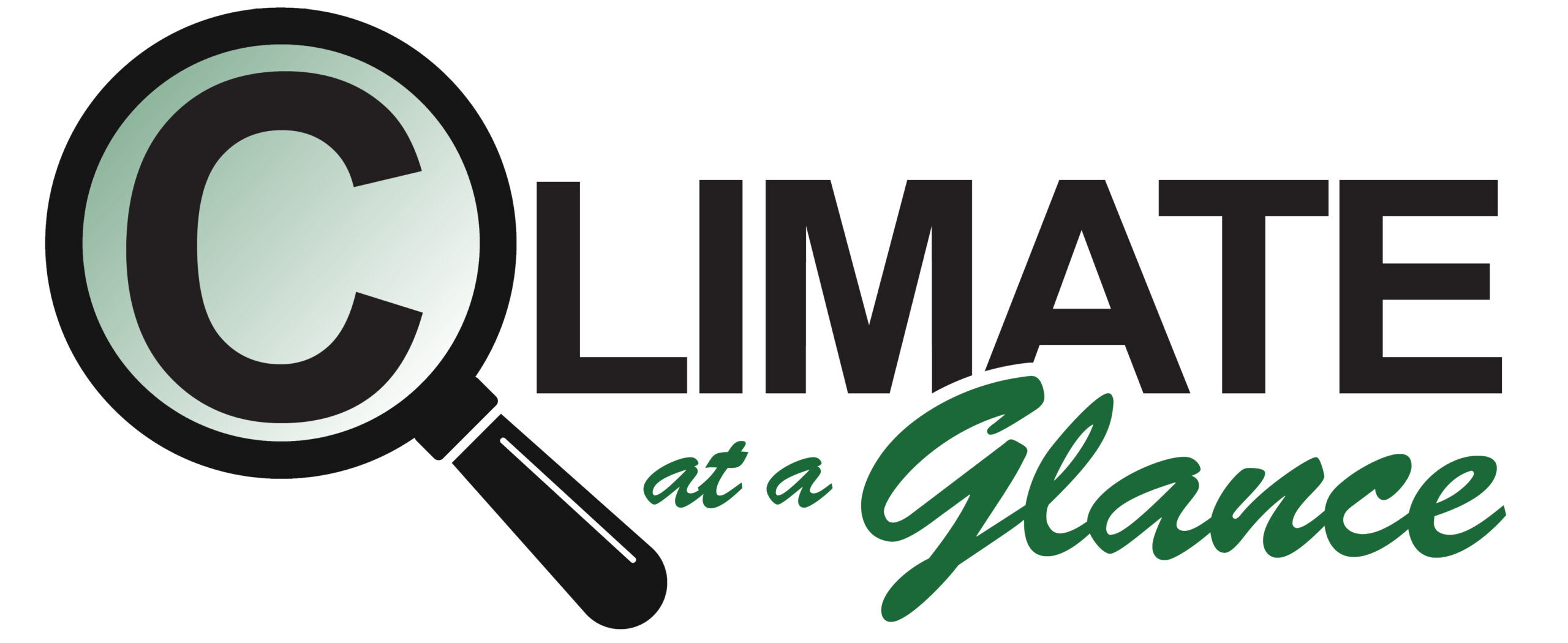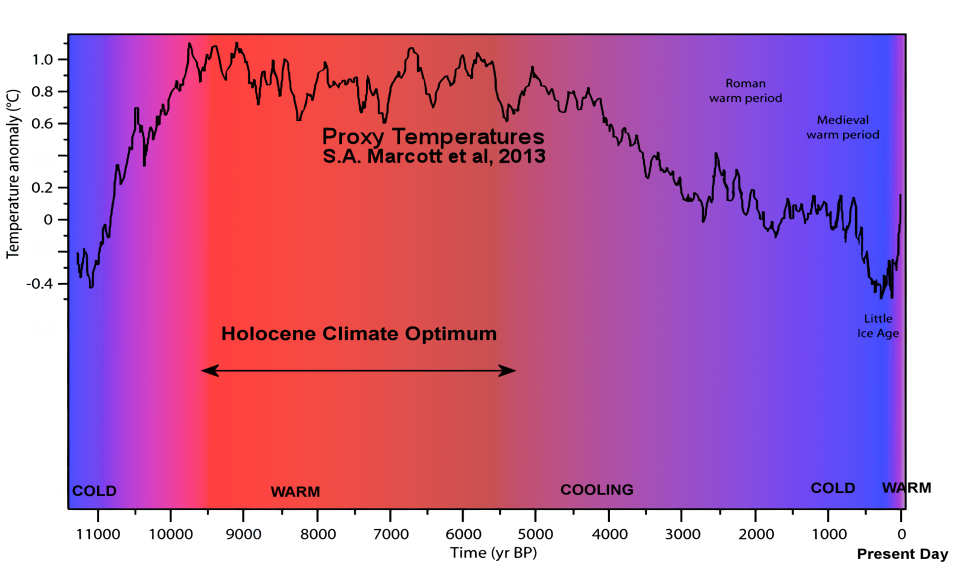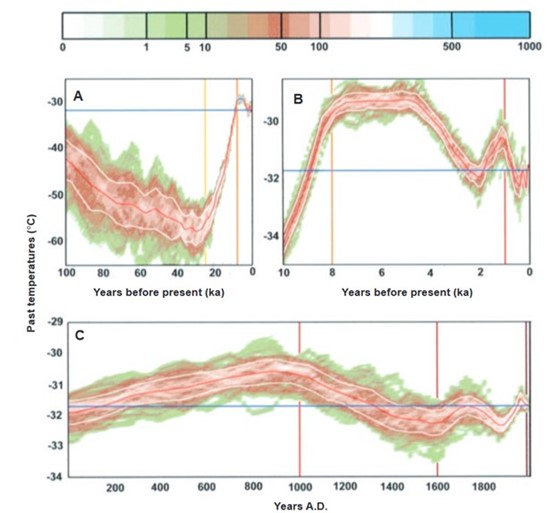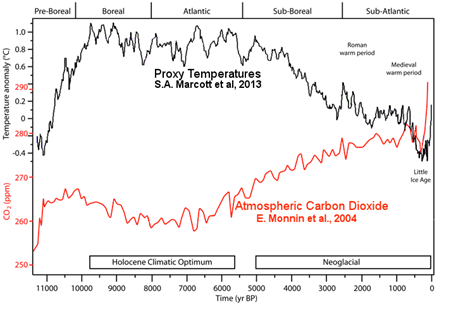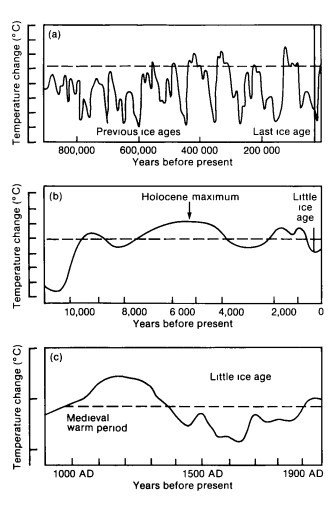Image: Temperature reconstruction from present day to 11,300 years ago showing the warmer than today period known as the Holocene Climate Optimum.
View this page as a printable (PDF) here: CAAG hottest in 125000 years
Key Takeaways:
- Climate activists and the mainstream media often claim temperatures have reached the “hottest in 125,000 years.”
- In reality, temperatures were warmer than the present for much of the past 10,000 years, including most of the time period that human civilization has existed.
- The warmer recent past has been long established by many data and sources, including the very first United Nations climate assessment.
- Any recent claims of “hottest in 125,000 years” must show with specificity how and why these many long-established temperature histories, which have long agreed with each other, are wrong, yet no compelling evidence has been presented.
Short Summary:
Present temperatures are unusually cool, not warm. Scientific data has long shown that temperatures throughout most of the past 10,000 years were as warm or warmer than today. Recent modest warming has not changed that. The unusually cool present temperatures have been reported and demonstrated by multiple peer-reviewed studies, data from the European Science Foundation, and even the very first United Nations climate assessment. 1,2,3,4
Even when we examine longer-term data, present temperatures are unusually cool. We are presently in a warm period between ice age glaciations. Proxy data suggests that every one of the previous six interglacial warm periods were warmer than the present.5,6
When climate activists claim temperatures are the hottest in 125,000 years, they are ignoring and attacking long-established scientific data.
In the image below, scientists plot past temperatures as shown from ice core samples taken from the Greenland ice sheet. The warming of the past 150 years is minor, and temperatures remain unusually cool compared with the past 10,000 years.7
Figure 1. Historic temperatures measured through Greenland ice cores. Since the last ice age glaciation ended 10,000 years ago, temperatures have typically been much warmer than today. Source: Dahl-Jensen et al, Science 283, 268 (1998).
Also, a 2013 study published in the peer-reviewed journal Science reconstructed temperatures from the present back to 11,300 years ago. As seen in Figure 2, the study confirms temperatures were much warmer during the Holocene Climatic Optimum than the present for most of the past 10,000 years.8,9
Figure 2: Temperature and carbon dioxide change during the Holocene. Black curve, global temperature reconstruction by Marcott et al., 2013. Red curve, CO2 levels as measured reported in Monnin et al., 2004.(reference 10) Importantly, Carbon Dioxide (CO2), in the red line, began increasing 8200 years ago even as temperatures, the black line, went down.
The very first climate assessment report in 1990 from the United Nations Intergovernmental Panel on Climate Change (IPCC) agreed. The chart below from the report shows that temperatures during most of the past 10,000 years were warmer than today.11
Figure 3: Temperature history according to the United Nations IPCC First Assessment Report. The top graph shows temperatures during the past 1 million years. The middle graph shows temperatures during the past 12,000 years. The bottom graph shows temperatures during the past 1,000 years. Present temperatures are at the far right. Source: IPCC First Assessment Report, United Nations, p. 202.
In summary, the multitude of credible, long-established scientific evidence conclusively shows that present temperatures are nowhere near the ‘hottest in 125,000 years.
References:
- Marsicek, J., Shuman, B., Bartlein, P. et al. Reconciling divergent trends and millennial variations in Holocene temperatures, Nature 554, 92–96 (2018), accessed 1/20/24, https://doi.org/10.1038/nature25464
- Lu et al., Temporal and spatial response of Holocene temperature to solar activity, Quaternary International, Volume 613, 10 March 2022, Pages 39-45, accessed 1/20/24, https://doi.org/10.1016/j.quaint.2021.09.006
- Liu et al., Proceedings of the National Academy of Sciences, The Holocene temperature conundrum, August 11, 2014, 111 (34) E3501-E3505, accessed 1/20/24, https://doi.org/10.1073/pnas.1407229111
- Darrell S. Kaufman, and Nicholas P. McKay, Climate of the Past, Technical Note: Past and future warming – direct comparison on multi-century timescales, CP, 18, 911–917, 2022, accessed 1/14/24, https://doi.org/10.5194/cp-18-911-2022
- NOAA, National Center for Environmental Information, What Are Proxy Data?, April 15, 2016, updated date, August 24, 2018, accessed 1/16/24, https://www.ncei.noaa.gov/news/what-are-proxy-data
- University of Calgary, Energy Education, Glacial and interglacial periods, accessed 2/5/24, https://energyeducation.ca/encyclopedia/Glacial_and_interglacial_periods
- D Dahl-Jensen et al., Past Temperatures Directly From the Greenland Ice Sheet, SCIENCE, 9 Oct 1998, Vol 282, Issue 5387, pp. 268-271, DOI: 10.1126/science.282.5387.268, accessed 2/5/24, https://www.science.org/doi/10.1126/science.282.5387.268
- Scholarly Community Encyclopedia, Holocene Climatic Optimum, 01 Nov 2022, accessed 1/16/24, https://encyclopedia.pub/entry/32197
- S.A. Marcott et al., Science, A Reconstruction of Regional and Global Temperature for the Past 11,300 Years, 8 Mar 2013, Vol 339, Issue 6124, pp. 1198-1201 DOI: 10.1126/science.1228026, accessed 1/14/24, https://www.science.org/doi/10.1126/science.1228026
- Monnin et al., Evidence for substantial accumulation rate variability in Antarctica during the Holocene, through synchronization of CO2 in the Taylor Dome, Dome C and DML ice cores, Earth and Planetary Science Letters, Volume 224, Issues 1–2, 2004, Pages 45-54, accessed 2/5/24, https://www.sciencedirect.com/science/article/pii/S0012821X04003115
- IPCC First Assessment Report, United Nations, Observed Climate Variations and Change, p. 202, accessed 2/5/24, https://archive.ipcc.ch/ipccreports/far/wg_I/ipcc_far_wg_I_chapter_07.pdf
Climate At A Glance is a Project of The Heartland Institute
Email: think@heartland.org
